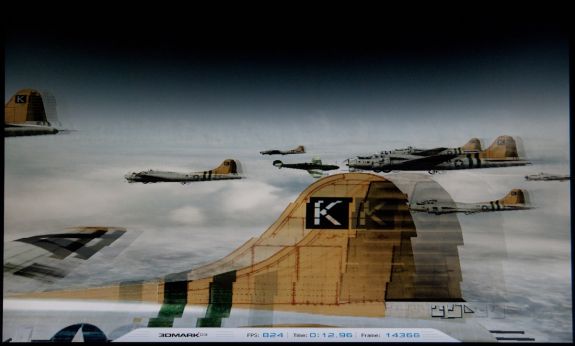Sceptre X270W-1080P Review: A Value 27" That Delivers
by Brian Klug on May 17, 2010 10:22 PM ESTDisplay Lag and Response Time
For gamers, display lag is a very real concern, and display processing is a nebulously reported (if at all) specification for just about all LCD displays. Ultimately, what matters isn’t GTG, full on, full off pixel response times, or what’s reported on the spec sheet, but the holistic latency of the monitor compared to something we can all agree is lag-free. We previously used a baseline LCD and compared with it as our benchmark of no display lag - we’ve since started using a 17” Princeton EO700 CRT. It supports 1024x768 at 85 Hz.
To do these tests, we connect the CRT up to a DVI to VGA adapter on our test computer’s ATI Radeon HD5870, and the LCD panel under test to DVI using an HDMI to DVI cable. I debated for some time the merits of using the same VGA signal, however, what really matters here is how the two display methods matter in the way that you, readers, are most likely to set things up. In addition, using the VGA input on any LCD is bound to add additional lag, as this is definitely a hardware scaler operation to go from analog to digital signaling, compared to the entirely digital DVI datapath. We run the CRT at 1024x768 and 85 Hz, its highest refresh rate, and clone the display to the LCD panel.
We use the same 3Dmark03 Wings of Fury benchmark on constant loop, take a bunch of photos with a fast camera (in this case, a Nikon D80 with a 17-50mm F/2.8) with wide open aperture for fast shutter speeds, in this case up to 1/800 of a second. Any differences on the demo clock will be our processing lag, and we’ll still get a good feel for how much pixel response lag there is on the LCD. As I mentioned earlier, the only downside is that this means our old data is no longer a valid reference.
To compute the processing lag, I do two things. First, I watch for differences in the clock between the CRT and LCD, noting these whenever they are visible. I did this for 10 captures of the same sequence. Second, one can compute the processing difference by taking into account the FPS and the frame number difference:
Of course, not every one of those frames is written to the display, but we can still glean how much time difference there is between these respective frames with much more precision than from averaging the time, which only reports down to 1/100ths of a second. An example shot of what this difference looks like on the X270W is the following:

CRT (left) vs. X270W (right) running Wings of Fury in 3Dmark 03
| Processing Lag | ||||
| Display | Averaging Time Difference | FPS Computation Time Difference | ||
| Dell G2410H | 9.0 ms | 8.59 ms | ||
| Sceptre X270W-1080P | 9.0 ms | 5.75 ms | ||
There’s an interesting trend emerging already, and we’ve only got two data points. First off, it’s obvious by now from doing these tests that relying on the time counter at the bottom of the 3Dmark 03 window is relatively unreliable - you either get 10 ms of difference (.01 seconds), or no difference at all. It’s very binary since the processing lag we’re looking for is effectively below our sampling rate, and as a consequence it takes a lot of these points to get data (I averaged 15). On the other hand, it’s very easy to weight the frame difference by FPS and compute the time between, and that tells a different story with greater precision. From those metrics, it’s apparent that the X270W does have lower processing lag than the G2410H. The difference is slight, however, at 2.84 ms - way under what the human eye can perceive - but a difference nonetheless.
We still don’t get near the 2 ms response quoted by Sceptre, but being roughly 6 ms slower than the CRT is pretty darn good, so good that I honestly don’t think it’s humanly possible to tell the difference.
LCD performance still isn’t technically at parity with CRTs, but you’d be hard pressed to tell the difference. There’s still a visible ghosting image before and after the primary frame, visible in the photo above. This is something virtually all the LCDs we’ve tested exhibit, but in practice the ghosting isn’t discernable at all.
I consider myself an avid PC gamer and threw the X270W at FPS, RTS, and RPG titles alike and never noticed ghosting or any perceptible lag, ever. I think it’s more than fair to say that the X270W is a worthy choice for gamers that are generally very discerning about their input lag. By the numbers, the X270W is the best we’ve tested with our new methods thus far, but then again we’ve only got two data points.












61 Comments
View All Comments
jwardell - Friday, November 11, 2011 - link
Too bad,I was looking for a 27" monitor for gaming. This seemed to fill the bill but it looks like it isn't available anymore.
The Samsung 27" P2770HD is currently available through costco for 270.00 but I suspect with all of the included electronics that the lag time would be longer than for a "pure" monitor.
Anyone know any reliable reviews of the samsung? I saw one at computerworld.com that stated that the Dell ultrasharp u2711 had a tv tuner! and that the res of the samsung was 2560 x 1440 ( I wish!) waste of time reading that review.